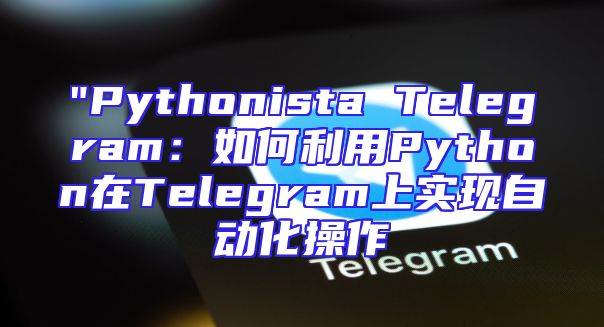"Pythonista Telegram:如何利用Python在Telegram上实现自动化操作
来源:本站时间:2025-06-22 04:33:46
在现代的数字世界中,Python已经成为了编程爱好者和专业人士的宠儿。而Telegram,作为一款流行的即时通讯应用,也因其强大的功能和广泛的用户群体而备受瞩目。结合Python和Telegram,我们可以实现许多有趣且实用的自动化操作。本文将详细介绍如何利用Pythonista和Telegram进行自动化编程。
首先,Pythonista是一款在iOS设备上运行的Python开发环境,它允许用户编写和运行Python代码。而Telegram则是一款全球流行的即时通讯软件,用户可以通过它发送文本、图片、视频等多种形式的信息。
以下是一些利用Pythonista和Telegram实现自动化的例子:
1. 自动回复消息:我们可以编写一个Python脚本,当接收到特定关键词的消息时,自动回复一个预设的文本或图片。
```python
from telethon import TelegramClient
from telethon.tl.functions.messages import GetHistoryRequest
from telethon.tl.types import MessageEntityMentionName
初始化Telegram客户端
api_id = '你的API_ID'
api_hash = '你的API_HASH'
phone = '你的手机号'
client = TelegramClient('session_name', api_id, api_hash)
连接到Telegram服务器
client.start(phone)
定义自动回复函数
async def auto_reply(client, message):
if '你好' in message.text:
await message.reply('你好,我是自动回复机器人!')
if '天气' in message.text:
await message.reply('今天的天气很晴朗哦!')
获取历史消息并处理
async def main():
async for message in client.iter_messages('你的用户名', limit=50):
await auto_reply(client, message)
运行主函数
client.loop.run_until_complete(main())
```
2. 自动发送消息:我们可以编写一个定时任务,在指定的时间发送消息。
```python
from telethon import TelegramClient
import datetime
初始化Telegram客户端
api_id = '你的API_ID'
api_hash = '你的API_HASH'
phone = '你的手机号'
client = TelegramClient('session_name', api_id, api_hash)
连接到Telegram服务器
client.start(phone)
定义定时发送消息函数
async def schedule_message(client, message, hour, minute):
now = datetime.datetime.now()
target_time = datetime.datetime(now.year, now.month, now.day, hour, minute)
while True:
if now >= target_time:
await client.send_message('你的用户名', message)
break
else:
now += datetime.timedelta(minutes=1)
运行定时发送消息函数
client.loop.run_until_complete(schedule_message(client, '祝你每天开心!', 12, 30))
```
3. 获取用户信息:我们可以编写一个脚本,获取指定用户的信息,如昵称、头像等。
```python
from telethon import TelegramClient
from telethon.tl.functions.users import GetUsersRequest

初始化Telegram客户端
api_id = '你的API_ID'
api_hash = '你的API_HASH'
phone = '你的手机号'
client = TelegramClient('session_name', api_id, api_hash)
连接到Telegram服务器
client.start(phone)
定义获取用户信息函数
async def get_user_info(client, user_id):
users = await client(function=GetUsersRequest([user_id]))
return users[0].id, users[0].first_name, users[0].last_name, users[0].photo
获取指定用户信息
user_id = 1234567890
info = await get_user_info(client, user_id)
print(f'用户ID:{info[0]}, 昵称:{info[1]} {info[2]}, 头像:{info[3]}')
```
以上是一些利用Pythonista和Telegram实现自动化的例子,相信通过这些例子,你已经对如何利用Pythonista和Telegram进行自动化编程有了初步的了解。希望这些内容能够帮助你更好地掌握Python和Telegram的使用技巧,让你的生活和工作更加便捷。